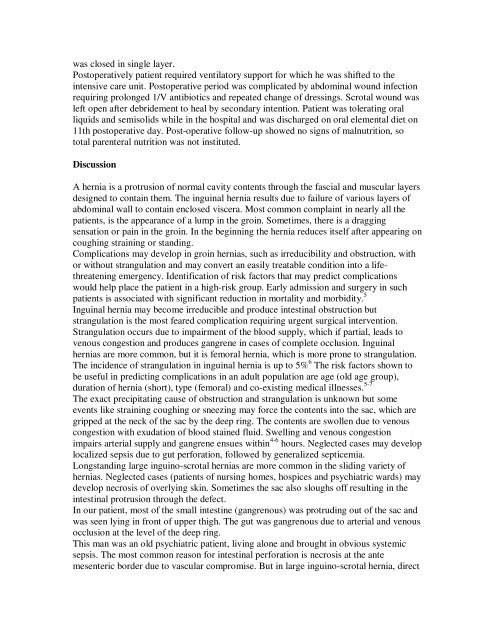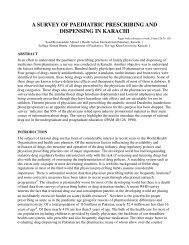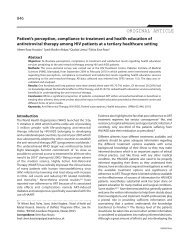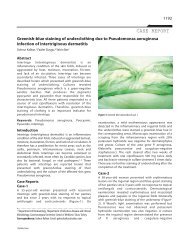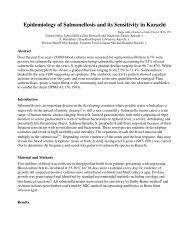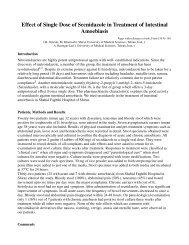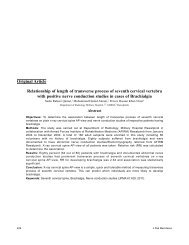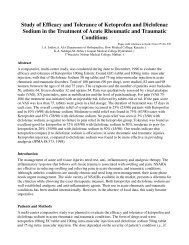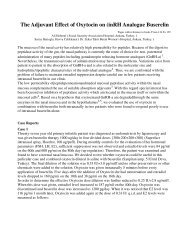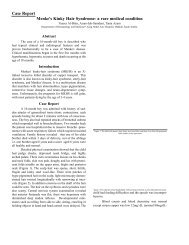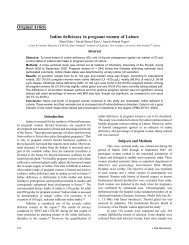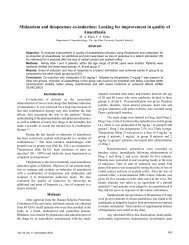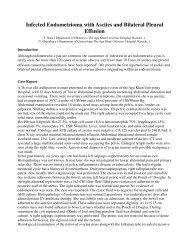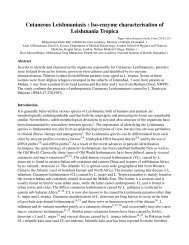Strangulated Inguinal Hernia: an Unusual Presentation - Journal of ...
Strangulated Inguinal Hernia: an Unusual Presentation - Journal of ...
Strangulated Inguinal Hernia: an Unusual Presentation - Journal of ...
You also want an ePaper? Increase the reach of your titles
YUMPU automatically turns print PDFs into web optimized ePapers that Google loves.
was closed in single layer.<br />
Postoperatively patient required ventilatory support for which he was shifted to the<br />
intensive care unit. Postoperative period was complicated by abdominal wound infection<br />
requiring prolonged 1/V <strong>an</strong>tibiotics <strong>an</strong>d repeated ch<strong>an</strong>ge <strong>of</strong> dressings. Scrotal wound was<br />
left open after debridement to heal by secondary intention. Patient was tolerating oral<br />
liquids <strong>an</strong>d semisolids while in the hospital <strong>an</strong>d was discharged on oral elemental diet on<br />
11th postoperative day. Post-operative follow-up showed no signs <strong>of</strong> malnutrition, so<br />
total parenteral nutrition was not instituted.<br />
Discussion<br />
A hernia is a protrusion <strong>of</strong> normal cavity contents through the fascial <strong>an</strong>d muscular layers<br />
designed to contain them. The inguinal hernia results due to failure <strong>of</strong> various layers <strong>of</strong><br />
abdominal wall to contain enclosed viscera. Most common complaint in nearly all the<br />
patients, is the appear<strong>an</strong>ce <strong>of</strong> a lump in the groin. Sometimes, there is a dragging<br />
sensation or pain in the groin. In the beginning the hernia reduces itself after appearing on<br />
coughing straining or st<strong>an</strong>ding.<br />
Complications may develop in groin hernias, such as irreducibility <strong>an</strong>d obstruction, with<br />
or without str<strong>an</strong>gulation <strong>an</strong>d may convert <strong>an</strong> easily treatable condition into a lifethreatening<br />
emergency. Identification <strong>of</strong> risk factors that may predict complications<br />
would help place the patient in a high-risk group. Early admission <strong>an</strong>d surgery in such<br />
patients is associated with signific<strong>an</strong>t reduction in mortality <strong>an</strong>d morbidity. 5<br />
<strong>Inguinal</strong> hernia may become irreducible <strong>an</strong>d produce intestinal obstruction but<br />
str<strong>an</strong>gulation is the most feared complication requiring urgent surgical intervention.<br />
Str<strong>an</strong>gulation occurs due to impairment <strong>of</strong> the blood supply, which if partial, leads to<br />
venous congestion <strong>an</strong>d produces g<strong>an</strong>grene in cases <strong>of</strong> complete occlusion. <strong>Inguinal</strong><br />
hernias are more common, but it is femoral hernia, which is more prone to str<strong>an</strong>gulation.<br />
The incidence <strong>of</strong> str<strong>an</strong>gulation in inguinal hernia is up to 5% 6 The risk factors shown to<br />
be useful in predicting complications in <strong>an</strong> adult population are age (old age group),<br />
duration <strong>of</strong> hernia (short), type (femoral) <strong>an</strong>d co-existing medical illnesses. 5-7<br />
The exact precipitating cause <strong>of</strong> obstruction <strong>an</strong>d str<strong>an</strong>gulation is unknown but some<br />
events like straining coughing or sneezing may force the contents into the sac, which are<br />
gripped at the neck <strong>of</strong> the sac by the deep ring. The contents are swollen due to venous<br />
congestion with exudation <strong>of</strong> blood stained fluid. Swelling <strong>an</strong>d venous congestion<br />
impairs arterial supply <strong>an</strong>d g<strong>an</strong>grene ensues within 4-6 hours. Neglected cases may develop<br />
localized sepsis due to gut perforation, followed by generalized septicemia.<br />
Longst<strong>an</strong>ding large inguino-scrotal hernias are more common in the sliding variety <strong>of</strong><br />
hernias. Neglected cases (patients <strong>of</strong> nursing homes, hospices <strong>an</strong>d psychiatric wards) may<br />
develop necrosis <strong>of</strong> overlying skin. Sometimes the sac also sloughs <strong>of</strong>f resulting in the<br />
intestinal protrusion through the defect.<br />
In our patient, most <strong>of</strong> the small intestine (g<strong>an</strong>grenous) was protruding out <strong>of</strong> the sac <strong>an</strong>d<br />
was seen lying in front <strong>of</strong> upper thigh. The gut was g<strong>an</strong>grenous due to arterial <strong>an</strong>d venous<br />
occlusion at the level <strong>of</strong> the deep ring.<br />
This m<strong>an</strong> was <strong>an</strong> old psychiatric patient, living alone <strong>an</strong>d brought in obvious systemic<br />
sepsis. The most common reason for intestinal perforation is necrosis at the <strong>an</strong>te<br />
mesenteric border due to vascular compromise. But in large inguino-scrotal hernia, direct


